Pita Pal is a restaurant in downtown Washington, PA, specializing in fresh and healthy pita sandwiches. Pita Pal aims to become the top lunch spot in the area, attracting locals and students. The restaurant expects to gain 35% new customers per year after the second year and achieve profitability by the end of year two.
Keys to Success:
1. Implementing strict financial controls, as the restaurant industry is highly competitive.
2. Offering high-quality, fresh, and healthy food to differentiate from competitors.
3. Ensuring proper visibility through an effective and targeted marketing campaign.
Food:
Pita Pal offers a diverse menu of pita sandwiches, salads, desserts, and coffee beverages. Pita bread, a Middle Eastern flatbread, serves as a healthy and tasty foundation for a variety of fillings, including Middle Eastern options like Hummus and Tabouli, as well as more traditional American choices.
Management:
Pita Pal is led by Steve Jones, an experienced professional in the restaurant industry. Steve gained valuable experience working in his family’s restaurant and at one of Washington’s finest establishments while in college. He also participated in Washington and Jefferson’s Entrepreneurship Program. With extensive experience and academic coursework, along with a starter loan from the school’s Entrepreneurship Program, Steve aims to establish a profitable niche lunch restaurant. Projected sales for year two and three are $145,299 and $203,676, respectively, with profitability expected to be achieved by the end of year two.
Mission:
Pita Pal’s mission is to provide Washington, PA with the finest, healthiest, and most delicious pita sandwiches. The restaurant is committed to delivering exceptional customer service, ensuring no dissatisfied customers leave.
1.1 Mission:
Pita Pal’s mission is to offer the finest, healthiest, and best-tasting pita sandwiches in Washington, PA. The restaurant is dedicated to providing the highest level of customer service to ensure customer satisfaction.
1.2 Keys to Success:
– Implement strict financial controls, vital for a retail food establishment.
– Offer high-quality lunch options.
– Ensure sufficient visibility through a strong marketing campaign.
1.3 Objectives:
– Become the premier sandwich shop in downtown Washington, PA.
– Continuously attract students for lunch, with a target of 35% new customers per year after the second year.
– Achieve profitability within the first two years.
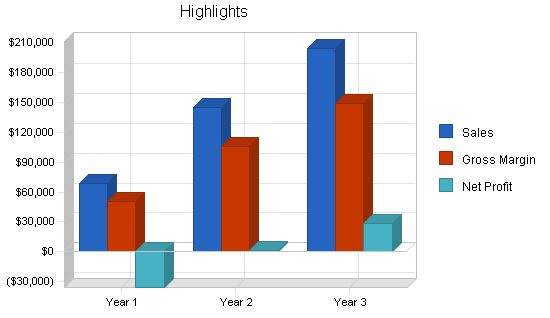
Pita Pal is a PA-based LLC formed by Steve Jones. The company is owned by Steve and will be located in downtown Washington, serving the lunch and early evening crowd.
2.1 Start-up Summary
As a start-up, Pita Pal will require equipment to begin operations. The following is a list of the needed equipment:
– Cash register
– Computer system with printer, CD-RW, and Internet connection
– Convection oven
– Refrigeration unit
– Blender/food processor
– Assorted knives, cutting boards, serving dishes, silverware, and food containers
– Shelving units
– Tables, chairs, tablecloths, and other accessories
– Lighting units
– Espresso machine and coffee maker (subsidized by the coffee vendor selling the beans)
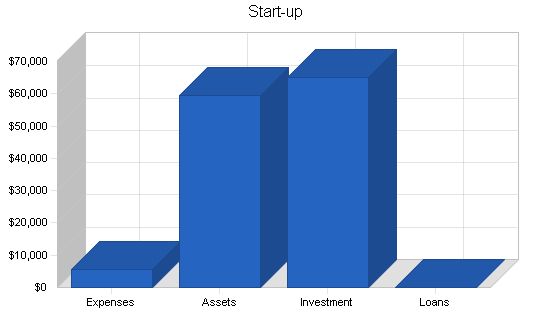
Start-up Funding:
– Start-up Expenses to Fund: $5,500
– Start-up Assets to Fund: $59,500
– Total Funding Required: $65,000
Assets:
– Non-cash Assets from Start-up: $25,000
– Cash Requirements from Start-up: $34,500
– Additional Cash Raised: $0
– Cash Balance on Starting Date: $34,500
– Total Assets: $59,500
Liabilities and Capital:
– Liabilities:
– Current Borrowing: $0
– Long-term Liabilities: $0
– Accounts Payable (Outstanding Bills): $0
– Other Current Liabilities (interest-free): $0
– Total Liabilities: $0
– Capital:
– Planned Investment:
– Entrepreneurship Program Loan: $40,000
– Investor 2: $25,000
– Additional Investment Requirement: $0
– Total Planned Investment: $65,000
– Loss at Start-up (Start-up Expenses): ($5,500)
– Total Capital: $59,500
– Total Capital and Liabilities: $59,500
– Total Funding: $65,000
Start-up Requirements:
– Start-up Expenses:
– Legal: $3,000
– Stationery etc.: $300
– Brochures: $500
– Consultants: $1,000
– Rent: $700
– Total Start-up Expenses: $5,500
– Start-up Assets:
– Cash Required: $34,500
– Other Current Assets: $0
– Long-term Assets: $25,000
– Total Assets: $59,500
– Total Requirements: $65,000
Company Ownership:
Pita Pal has been formed as a limited liability company in Pennsylvania. The L.L.C. business formation has been chosen to protect the owner from personal liability and avoid double taxation associated with a traditional corporation.
Services:
Pita Pal is a downtown-based sandwich shop serving lunchtime hours as well as early evening, weekdays from 10-6 pm. Pita bread is chosen for its uniqueness, healthiness, and versatility. Each customer can choose from a variety of fillings for their pita sandwiches, including tofu pate, falafel, hummus, baba ganouj, tabouli, turkey, ham, chicken, pesto, assorted vegetables, and assorted cheeses. In addition to pitas, there will be various salads, both green and pasta, assorted desserts, espresso, and coffee.
Market Analysis Summary:
Pita Pal will serve the Washington, PA lunchtime and early evening crowd, targeting two distinct market segments: students of Washington and Jefferson College and "towners." Students will be attracted to Pita Pal as a better alternative to their on-campus meal plan, while towners will appreciate the selection and change from the traditional offerings on Main Street. Main Street in Washington has experienced a downtown renaissance, with many businesses attracting hungry lunchtime workers.
The competitive environment that Pita Pal faces is not too stiff. Most lunchtime options in downtown Washington consist of traditional diner food, which may appeal to older residents but not to college students and those seeking healthier options. Pita Pal is expected to be a big hit in this market.
Market Segmentation:
Pita Pal has segmented the market into two distinct segments: students and towners.
– Students:
– 75% of students receive financial aid
– 67% have a part-time job
– Ages 17-22
– 42% were in the top 15% of their high school class
– 36% were in the 85th percentile for the SAT
– 89% eat out at least twice per week
– 75% are on the school food program
– Towners:
– Ages 24-55
– Average individual income is $38,000
– 55% have at least some undergraduate schooling
– 44% work within a seven-minute walk from the downtown area
– 76% go out for lunch one to two times a week
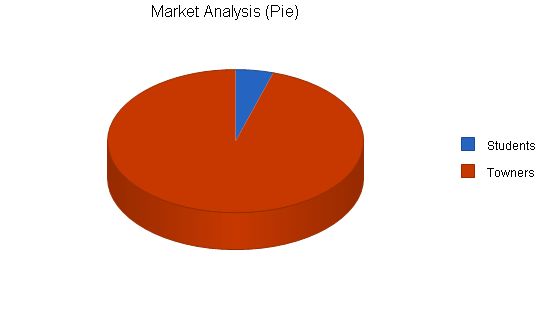
Market Analysis:
– Year 1 to Year 5:
– Potential Customers: Students – 8% Growth, 2,285 to 3,108, 7.99% CAGR; Towners – 8% Growth, 45,989 to 62,567, 8.00% CAGR; Total – 8% Growth, 48,274 to 65,675, 8.00% CAGR.
4.2 Target Market Segment Strategy:
– Pita Pal will have two marketing campaigns for two different market segments. Students spend most of their day on campus and venture off campus for lunch. The marketing effort to reach students will be based on written media, The General, student newspaper. The towners will be reached through the local newspaper, as they work downtown and patronize downtown businesses.
4.3 Service Business Analysis:
– Pita Pal operates within the fast food and fast casual niches of the restaurant industry. Orders are placed at the counter and served quickly like fast food, but the menu is more limited and prices are higher like fast casual. Pita Pal aims to reach profitability within two years.
4.3.1 Competition and Buying Patterns:
– Pita Pal faces competition from traditional fast food chains, healthier alternatives like Subway, Brothers pizza (popular with locals, not college students), delis serving basic deli fare, traditional diners, and on-campus food service for students with poor food offerings.
Strategy and Implementation Summary:
– Pita Pal’s business strategy focuses on emphasizing its healthy, custom food options. Their competitors cannot compete with Pita Pal’s healthy menu and flexibility in customizing offerings. This competitive edge will be stressed in the marketing campaign. Pita Pal aims to ensure 100% customer satisfaction and will take any necessary actions to correct problems.
5.1 Competitive Edge:
– Pita Pal’s competitive edges are its healthy menu that minimizes fried foods and uses vegetables, and its customization where customers can choose from a variety of ingredients to build their pita pocket.
5.2 Marketing Strategy:
– Pita Pal will use print advertisements and coupons in the student publications to reach students. The marketing campaign will emphasize Pita Pal as a tasty, healthy alternative to the campus meal plan and other local food vendors. For towners, print advertising in the local paper, The Sentinel, will be effective. Flyers will also be distributed in the downtown area to raise awareness of Pita Pal’s opening.
5.3 Sales Strategy:
– Pita Pal prioritizes 100% customer satisfaction and believes that maintaining current customers is more cost-effective than attracting new ones. Quality food is essential to support the customer-centered service. The menu is designed to offer a wide selection of fresh, healthy, and cost-effective dishes. Both a quality product and excellent service will contribute to increased sales in the long term.
5.3.1 Sales Forecast:
– Pita Pal has a conservative sales forecast, expecting slow business in the first three months with steady growth over the first two years. Profitability is projected to be achieved towards the end of year two.

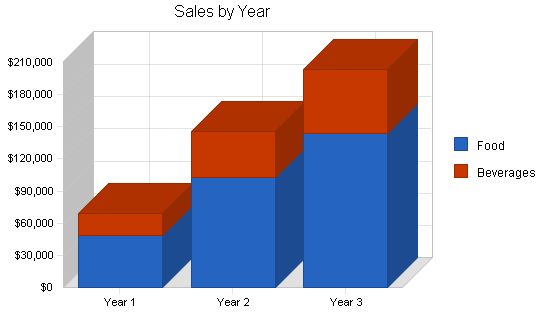
Sales Forecast
| Sales Forecast | |||
| Year 1 | Year 2 | Year 3 | |
| Food | $48,361 | $102,323 | $143,434 |
| Beverages | $20,312 | $42,976 | $60,242 |
| Total Sales | $68,673 | $145,299 | $203,676 |
| Direct Cost of Sales | Year 1 | Year 2 | Year 3 |
| Food | $14,508 | $30,697 | $43,030 |
| Beverages | $4,062 | $8,595 | $12,048 |
| Subtotal Direct Cost of Sales | $18,571 | $39,292 | $55,079 |
5.4 Milestones
Pita Pal has identified four clear and achievable milestones:
- Business plan completion. The final version will be accomplished within the first two months.
- $50,000 in revenue. A specific date has been established to gauge performance.
- Profitability. It is forecasted to occur within two years.
- Payback of entrepreneurship loan. Non-payment will not result in serious consequences, but it is a matter of pride to turn a loan from the College’s Entrepreneurship Program into a successful business.
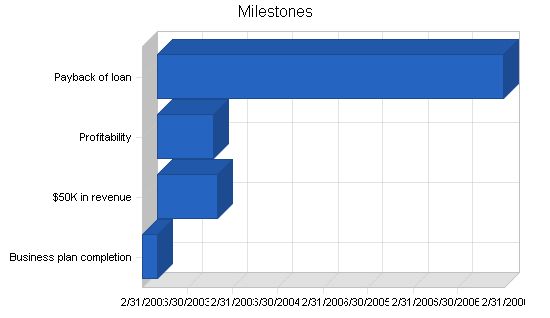
Milestones:
– Business plan completion: 1/1/2003 – 3/1/2003, $0 budget, Steve – Operations
– $50K in revenue: 3/1/2003 – 11/1/2003, $0 budget, Steve – Sales
– Profitability: 3/1/2003 – 10/15/2003, $0 budget, Steve – Accounting
– Payback of loan: 3/1/2003 – 1/1/2007, $0 budget, Steve – Accounting
– Totals: $0 budget
Management Summary:
Steve Jones is the driving force behind Pita Pal. He has lived in Washington, PA for the last four years while studying for his Bachelor of Arts from Washington and Jefferson College. Steve’s introduction to the restaurant industry came at the age of 14 when he worked in his family’s restaurant in Cleveland.
While pursuing his degree, Steve was a server at a fine dining restaurant called Angelo’s, where he gained more insight into the restaurant industry. He enrolled in the Entrepreneurship Program, which combined coursework with speakers and empirical experience. For some participants, it also provided a low-interest loan that doesn’t require personal repayment if the business fails.
As Steve became more active in the program, he realized that he would not be truly happy unless he operated his own business. He also recognized that he would be most effective in the restaurant industry due to his experience and the contacts he had from his parents’ business. With this in mind, at the end of his last semester, Steve applied for a loan through the Entrepreneurship Program and was pleasantly surprised to win. He wrote a business plan in response to the loan application requirements, but by the time the loan was awarded, many months had passed. Steve felt the need to rewrite the plan before starting the business, and he undertook this task.
Personnel Plan:
Steve will be the main employee of Pita Pal. For the first two months of operation, Steve will be the sole employee. During this period, he will oversee the finishing touches on the retail space, develop product recipes, and establish vendor relationships. From month three onwards, Steve will have at least two employees present during open hours. He will also have one employee working 1.5 hours before opening to help with food prep, and both employees for 0.5-1 hour after closing. As business ramps up, Steve will hire additional employees for food prep, front restaurant help, and back kitchen activities such as dishes and cleanup.
Personnel Plan:
– Steve: Year 1 – $24,000, Year 2 – $27,000, Year 3 – $30,000
– Employee 1: Year 1 – $9,000, Year 2 – $10,800, Year 3 – $10,800
– Employee 2: Year 1 – $9,000, Year 2 – $10,800, Year 3 – $10,800
– Employee 3: Year 1 – $7,200, Year 2 – $10,800, Year 3 – $10,800
– Employee 4: Year 1 – $5,400, Year 2 – $10,800, Year 3 – $10,800
– Total People: 5
– Total Payroll: Year 1 – $54,600, Year 2 – $70,200, Year 3 – $73,200
Hello!
I’m Andrew Brooks, a seasoned finance consultant from the USA and the mind behind phonenumber247.com.
My career is built on a foundation of helping individuals and businesses thrive financially in an ever-changing economic landscape. At phonenumber247.com, my aim is to demystify the complex world of finance, providing clear, actionable advice that can help you navigate your financial journey with confidence. Whether it’s personal finance management, investment strategies, or understanding the nuances of market dynamics, I’m here to share insights and tools that can propel you towards your financial goals.
Welcome to my digital space, where every piece of advice is a step closer to financial clarity and success!
